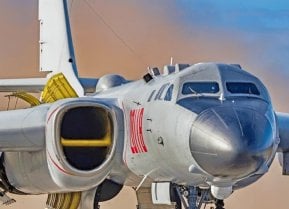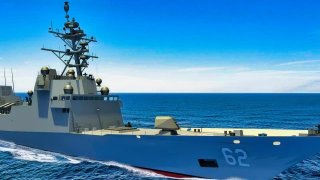Why the U.S. Navy Needs the Constellation-Class Frigate to Be a Success
The U.S. Navy’s fourth Constellation-class guided missile frigate will be commissioned in 2029. It must be a success for many reasons.
The U.S. Navy’s fourth Constellation-class guided missile frigate will be commissioned in 2029.
According to the service, the new vessel will be named USS Lafayette (FFG 65). “Increased numbers of smaller multi-mission combatants, such as Constellation-class Frigates (FFG 62), enable more efficient distribution of missions across the surface fleet, freeing up the more capable [guided-missile destroyers] for critical high-end missions,” reads the long-range shipbuilding plan, obtained by USNI News in April. The Constellation-class frigates follow the littoral combat ships of both the Navy’s Freedom and Independence classes.
Constellation-class Is Coming Soon
When the USS Lafayette hits the waters later in the decade, it will join the USS Constellation, USS Congress, and USS Chesapeake.
The Navy has asserted that this incoming vessel will have the multi-mission capabilities to conduct information operations, air warfare, surface warfare, electronic warfare, and anti-submarine warfare.
Over the last decade, the Navy began seeking new frigate designs that could be fitted with enhancements required by the changing threat environment. Specifically, the service desired a frigate class that could keep up with aircraft carriers and possess sensors.
Back in 2018, six shipbuilders submitted design proposals to be considered by the Navy. Around this time, the service announced that five of these shipbuilders had been awarded $15 million contracts to produce design prototypes for the frigate, which were Fincantieri Marine Group, Austal USA, Huntington Ingalls Industry, General Dynamics, and Lockheed Martin.
In 2020, Fincantieri Marinette Marine’s frigate design was selected as the winner, and the shipbuilder was awarded a $795 million contract to continue its design efforts. By the summer of 2021, the USS Congress began its development phase.
A Brief History of Frigates
Frigates have existed in navies since at least the 17th to early 18th centuries. The name was given to any full-rigged ship designed for surveillance duties. The true frigate designation was first used in France and applied to ships that featured one armed deck on top with an unarmed deck below. After the Second World War, the concept of frigates shifted. The designation was still given to smaller ships that were larger in size than corvettes but smaller than destroyers. The introduction of guided missiles altered the function of these ships and their mission sets expanded to include anti-air and anti-surface operations.
The Navy is hopeful that the introduction of its Constellation-class frigates will boost its overall ship numbers. According to the service, its goal is to develop a fleet size of 355 manned ships. A little less than one-third of these vessels are set to be large surface combatants like destroyers, while 50 are intended to be small surface combatants, and the remaining 20 will be frigates. The Navy initially developed the two-variant Littoral Combat Ship (LCS) program to fulfill its capability needs, which has had some unintended consequences.
What Happened to the Navy’s Littoral Combat Ships?
As detailed by Naval Technology, “However, difficulties with the LCS program have seen a number of ships retired after only a handful of years of service, with questions over the suitability of the platforms and their survivability in contested maritime environments. The difficulties experienced by the LCS also appear in part to have been the motivation behind the US decision to initiate the FFG(X) program, now known as the Constellation class, which will deliver up to 20 frigates into USN service. At between $500-600m per ship, the Constellation class is around 50% more expensive per ship than the LCS, although as a much larger warship (7,200t fully loaded) than the LCS Independence variant (3,400t full loaded) and Freedom variant (~3,500t), it necessarily has greater capability, and crucially, survivability.”
The Navy is hoping its Constellation-class frigates function better than the Littoral Combat Ship or LCS-class. Recently, the service implemented its first combat systems software package for the FFG 62 Constellation-class lead warship. A variant of the Aegis Weapon System Baseline 1-, the software is modified to meet the needs required by the Frigate-class.
Additionally, the incorporation of this software helps lay the foundation for Aegis weapon system integration. Lockheed Martin has described the significance of this implemented software. “The CSL supports a number of the Surface Navy’s platforms, including Aegis Cruisers and Destroyers, Littoral Combat Ships, Coast Guard Cutters, and International Aegis-equipped Allies. The CSL also reduces the Navy’s costs through common software development, systems engineering, and training. As the U.S. Navy’s Combat System Engineering Agent (CSEA) for the Aegis Combat System, we delivered the first Frigate BL10 software delivery by combining the best of existing Navy programs, the adaptability of the CSL, and advances in CSEA technology to bring a custom product to the Navy’s newest Surface ship class.”
Now that tensions between Washington and Beijing are peaking, alongside the geopolitical crises unfolding in Eastern Europe and the Middle East, the U.S. Navy’s capabilities are even more significant.
About the Author
Maya Carlin is an analyst with the Center for Security Policy and a former Anna Sobol Levy Fellow at IDC Herzliya in Israel. She has by-lines in many publications, including The National Interest, Jerusalem Post, and Times of Israel. You can follow her on Twitter: @MayaCarlin.


